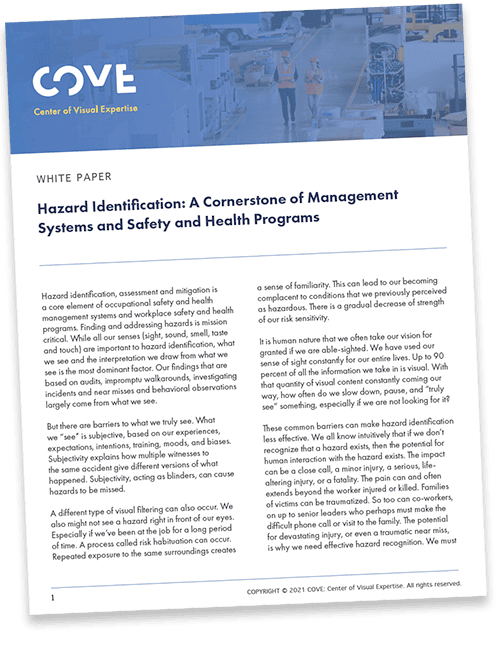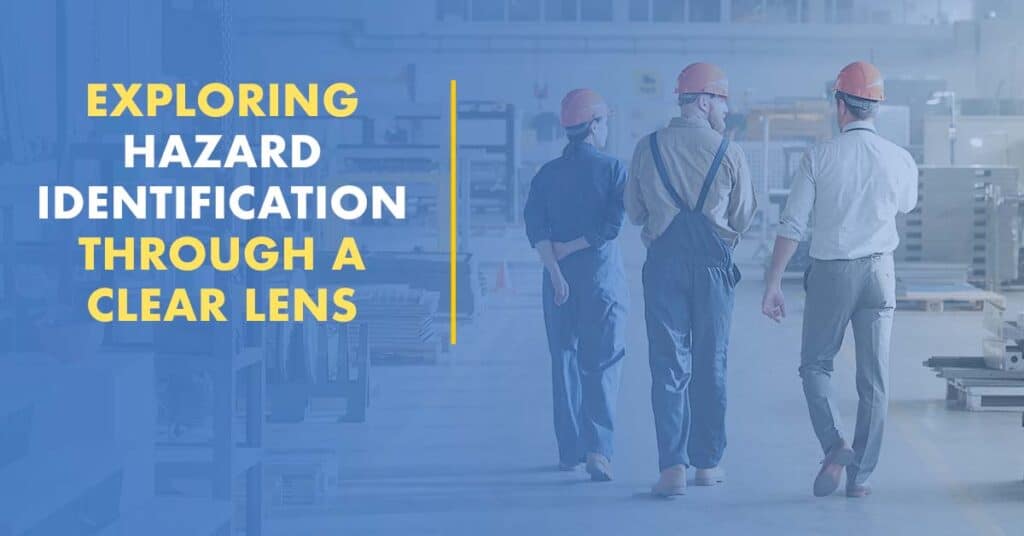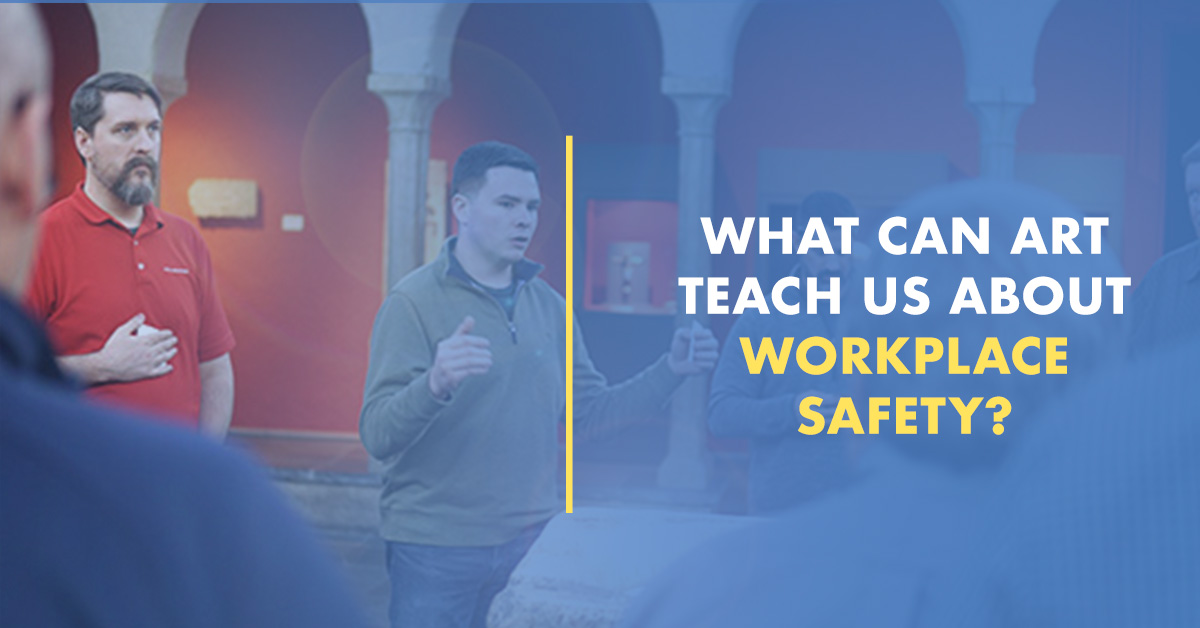An Introduction to “Hazard Identification: A Cornerstone of Management Systems and Safety and Health Programs.”
While it may be obvious that hazard identification in the workplace requires all senses, specifically sight, there are many barriers and biases that can prevent employees from identifying issues and “seeing” through a clear lens. In this article, we discuss the significant role sight plays in hazard recognition, how this sense becomes easily impaired, and how to start correcting the behaviors and removing the biases to improve the efficacy of hazard identification. Not truly seeing what is at play can have detrimental effects on a workplace, but as employees are trained to become visually literate, they can reduce their exposure to harm and improve safety for them and those around them.
The Link Between Visual Literacy, Hazard Identification, & Workplace Safety
As part of occupational safety and health management systems and workplace safety programs, hazard identification processes are fundamental. After all, identifying conditions in the workplace and fixing them can eliminate risks that employees can encounter and reduce the hazards that have the potential for injury. Therefore, it is no surprise that hazard identification plays a significant role in improving workplace safety. If an organization can reduce hazards and exposures to risks, they have a high chance of yielding better performance outcomes, both in safety and operationally.
But for any of the above to be true, hazard recognition must be performed properly. Using the five senses (sight, sound, smell, taste, and touch) are critical, but what we see (and the interpretation we draw from what we see) is the dominant factor in identifying hazards. About 90% of the information we take in as individuals is visual, so what we see really matters to how effective our hazard recognition efforts are. The ability to see makes all the difference in hazard recognition and if employees were more capable of seeing what was in front of them by being more visually literate, they could eliminate injuries before they happen and fix the issues that prevent future incidents.
Common Biases to Seeing & Working Safely
Familiarity can be a disservice.
If we take a minute to think about how people identify hazards in the workplace, chances are many employees have been trained in hazard recognition. They may even consider themselves experts, and they’re not wrong. However, it is also likely that these experts have been working in dangerous environments and are almost too familiar with the risks. While it is important to have experience and knowledge in this area, what can typically happen is “risk habitation” where one has had so much exposure to the same surroundings that they become complacent to conditions that were previously perceived as hazardous. When risk habitation happens, a person may overlook or even miss key safety issues.
Subjectivity can be a blinder.
Another bias to keep in mind is that seeing is subjective, based on our experiences, expectations, intentions, training, and moods. Subjectivity explains how multiple witnesses to the same accident give different versions of what happened. Subjectivity, acting as a blinder, can cause hazards to be missed.
Regardless of the bias, the important takeaway is that both can contribute to inadequate hazard recognition practices. And as we know from OSHA, failure to identify or recognize hazards is frequently one of the root causes of workplace injuries and illnesses, and indicates that the workplace’s safety and health program needs improvement. Seeing better through visual literacy is the solve for better hazard recognition.
Building a Visually Literate Workforce
If an injury or illness occurs in the workplace it was most likely caused by an existing hazard or unsafe condition. But no organization should have to wait for an incident to happen to correct a hazard that exists. In our recent white paper, we discuss how visual literacy allows organizations to see clearly and get ahead of incidents before they happen. A workforce that is visually literate can objectively identify, understand, interpret, assess hazards for their risk potential, problem-solve and communicate.
Building a visually literate workforce, of course, does not happen overnight and or in silo. It requires (at minimum):
- A strong safety culture where employees take an active role in their safety processes and work together proactively (with leadership support) to reduce incidents.
- Critical thinking skills that allow for more responding and less reacting. Being able to analyze, interpret, explain, self-regulate, while also having an open mind contribute to effective hazard recognition.
- Communication across the organization. Incidents can be caused by a simple communication breakdown, which is why communicating hazards and sharing discoveries and how to resolve issues is key for risk mitigation. Communication also engages employees, and those that are involved, attentive, and feel supported by their organization have a higher chance of contributing to a strong safety culture.
- Visual literacy training enterprise wide. Visual literacy training improves visual acuity, critical thinking, objectivity, workforce engagement and the processes used in hazard recognition. Training also enables the development of sustainable solutions, so what is learned can be used and applied long-term.
The Road to Seeing Clearly
To improve the ability to see and break down the barriers preventing employees from working safely, organizations must weave visual literacy into their safety processes, starting with hazard recognition. Building a visually literate workforce is an enabler to more effective hazard recognition. Training is critical, and not just to teach new concepts and applications, but to also retrain the mind that has become comfortable with their surroundings and is susceptible to oversights. Visual literacy will not only help uncover the blind spots in hazard recognition, but it will also help the organization create a safer working environment and achieve better performance outcomes.

To learn more about visual literacy and how it contributes to more effective hazard recognition and improved safety performance, download our recent white paper on An Introduction to Hazard Identification: A Cornerstone of Management Systems and Safety and Health Programs.
This paper provides an in-depth discussion on why it’s critical to incorporate visual literacy into hazard recognition processes and offers practical applications to consider using at your organization.




